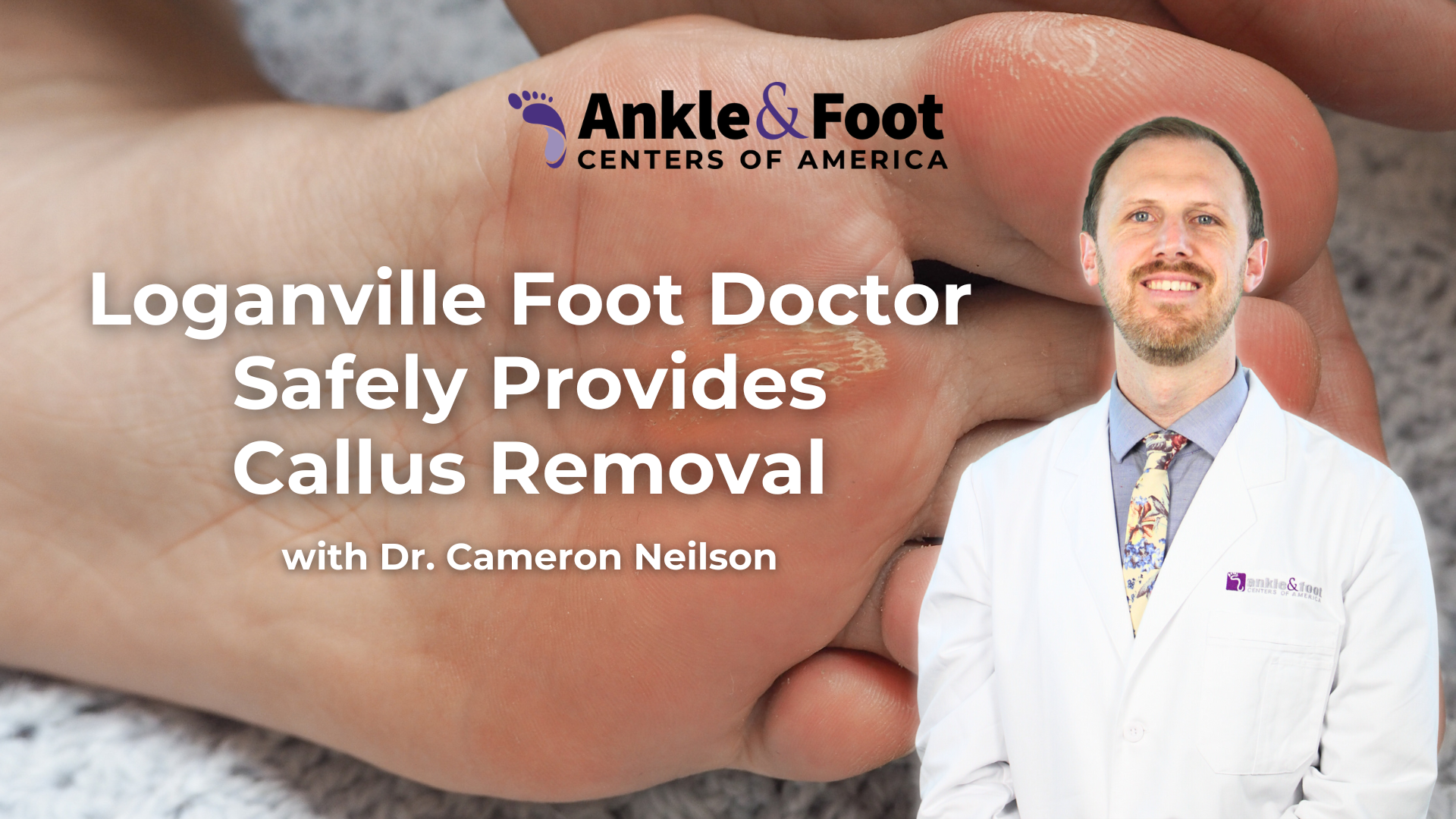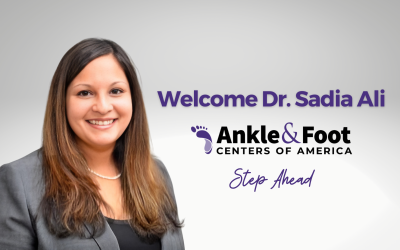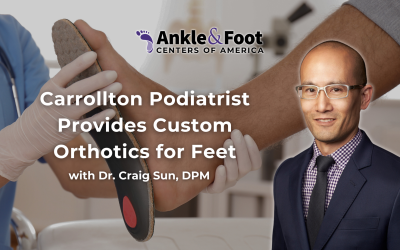Table of Contents
Callus Removal in Loganville
Calluses, the thickened layers of skin on feet, often result from repeated pressure. These act as a protective barrier but can become painful if not managed. Therefore, it’s essential to remove calluses cautiously, as improper removal can lead to infections or skin damage.
In Loganville, a professional foot doctor is making strides in offering safe and effective callus removal services. This article aims to shed light on the significance of seeking professional help for foot callus removal and will introduce you to a trusted Loganville podiatrist renowned for his expertise and patient care.
Who is the Loganville Foot Doctor?
Dr. Cameron Neilson, a highly skilled specialist, provides expert care for foot and ankle conditions in Loganville. His journey started at Brigham Young University and continued at Samuel Merritt University’s College of Podiatric Medicine.
His professional interests particularly focus on sports medicine, showcasing his dedication to helping athletes and active individuals maintain peak performance and recover from injuries effectively. Dr. Neilson offers a full range of services for foot and ankle care.
Dr. Neilson is affiliated with several top hospitals in the area, including Piedmont Eastside Medical Center in Snellville, Piedmont Atlanta Hospital, Emory Decatur Hospital, and Wellstar LaGrange Hospitals. This extensive network allows him to provide his patients with the best possible care in both outpatient and hospital settings.
What are Calluses?
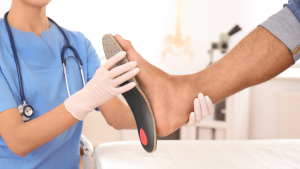
Calluses are thickened, hardened areas of skin that develop as a response to repetitive friction, pressure, or irritation. These patches typically form on the feet, where constant rubbing against shoes or the ground induces the skin to protect itself by building up layers of dead skin cells.
Why Do Calluses Form?
Calluses commonly arise from wearing ill-fitting shoes, engaging in activities that put excessive pressure on the feet, or having an abnormal walking style that unevenly distributes weight. They serve as a natural cushion over bones in high-stress areas, helping to protect the skin and underlying tissues from damage. However, without proper management, calluses can lead to discomfort and other complications.
Importance of Professional Care
Many try removing calluses at home, which can be risky if not done correctly. Improper removal can lead to cuts, infections, or worsened calluses. People with diabetes or peripheral neuropathy, who may not normally feel pain due to nerve damage, are particularly at risk for complications from home callus removal methods. Therefore, it is highly advisable to seek professional help for callus treatment to avoid potential health risks.
The Process and Benefits of Professional Removal
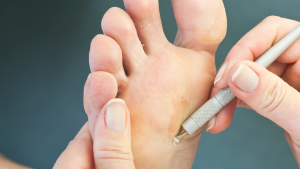
Professional callus removal, done by experts like Dr. Neilson, ensures safety and minimizes discomfort. Here’s what the process involves:
The Tools and Techniques Used for Safe Callus Removal
- Debridement: This is the most common method used for callus removal. Dr. Neilson uses specialized sterile instruments to carefully trim away the thickened skin. The procedure is gentle and controlled to avoid damaging healthy tissue underneath the callus.
- Cryotherapy: For harder, more persistent calluses, cryotherapy may be used. This involves applying extreme cold to freeze and remove the dead skin cells effectively.
- Custom Orthotics: If calluses are caused by foot alignment issues or abnormal gait, Dr. Neilson may recommend custom orthotics. These are specially designed insoles worn inside the shoes to correct the foot alignment and redistribute pressure evenly across the foot, thereby preventing callus reformation.
- Medications: In some cases, topical medications might be applied to soften the calluses before removal or to treat any underlying skin condition contributing to callus formation.
Aftercare Advice and Preventive Measures
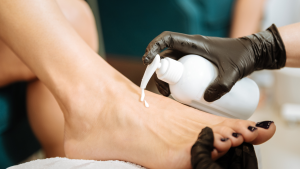 After removal, Dr. Neilson provides aftercare instructions to ensure proper healing and prevent future calluses.
After removal, Dr. Neilson provides aftercare instructions to ensure proper healing and prevent future calluses.
- Moisturizing and Care: Regular application of a good quality moisturizer to keep the skin soft and prevent dryness, which can lead to callus formation.
- Proper Footwear: Guidance on selecting the right shoes that provide adequate support and cushioning, fit well, and do not cause excessive pressure on any part of the foot.
- Regular Check-ups: Scheduled follow-up appointments to monitor the foot’s condition and make any necessary adjustments to treatment or preventive measures.
What to Expect During Your Visit at Ankle & Foot Centers of America
Visiting the Ankle & Foot Centers of America for the first time is designed to be a reassuring and positive experience under the care of Dr. Cameron Neilson and his team. Here’s what to expect:
Arrival and Check-In: Upon arrival, a friendly staff member will assist you with check-in procedures, including providing your identification and insurance information, and completing necessary paperwork.
Initial Consultation: Your visit starts with a one-on-one consultation with Dr. Neilson, who will review your medical history and discuss any current symptoms and issues related to your feet. This consultation includes a thorough examination to assess conditions like calluses or other foot deformities.
Diagnostic Procedures: If needed, Dr. Neilson may conduct or order diagnostic procedures such as digital imaging or non-invasive scans to accurately diagnose your condition and tailor a personalized treatment plan.
Discussion of Treatment Options: Post-evaluation, Dr. Neilson will discuss treatment options that may range from callus removal to prescription medications, custom orthotics, or surgical interventions if necessary, ensuring you are well-informed to make decisions about your healthcare.
Treatment: Treatments like callus removal can be performed during your visit using the latest techniques for minimal discomfort. For more complex treatments requiring long-term management, follow-up schedules will be discussed.
Aftercare and Prevention: Before leaving, you’ll receive detailed aftercare instructions to ensure proper healing and prevent future issues, including advice on foot care routines and shoe recommendations.
Scheduling Follow-Up: Lastly, the clinic’s staff will help schedule any necessary follow-up appointments, facilitating a smooth continuation of your treatment.

Conclusion
Seeking professional treatment for callus removal and other foot-related issues is a critical step towards maintaining overall foot health and enhancing quality of life. Throughout this blog, we’ve explored the comprehensive and meticulous approach taken by Dr. Cameron Neilson at the Ankle & Foot Centers of America in Loganville. His expertise and the advanced care provided at his clinic demonstrate the importance of professional intervention in managing common yet potentially problematic conditions like calluses.
Dr. Neilson’s patient-centered approach not only addresses the immediate discomfort caused by calluses but also delves into the underlying issues that may contribute to their formation. By choosing professional care, patients benefit from a holistic treatment plan that includes state-of-the-art techniques, personalized advice, and preventive strategies tailored to each individual’s needs.
Moreover, the benefits of opting for professional callus removal include ensuring safety, preventing infections, and receiving educated guidance on foot care, which DIY methods cannot offer. This professional care is essential, particularly for those with underlying health conditions such as diabetes, which can complicate foot issues and lead to serious health risks if not managed properly.
We encourage anyone experiencing foot discomfort or visible calluses not to delay seeking professional advice. Booking a consultation with a specialist like Dr. Neilson can provide you with the necessary care and peace of mind that your foot health is in good hands. Remember, taking care of your feet is not just about addressing current problems but preventing future issues and maintaining mobility and independence.
For those interested in taking the first step toward better foot health, we invite you to visit Ankle & Foot Centers of America for more information or to schedule an appointment. Please feel free to contact Dr. Neilson’s office at 678-750-9941. Don’t let foot problems hold you back—reach out today and stride forward into a healthier tomorrow.
Q&A Section
Q: Why is there a small hard spot on the bottom of my foot?
 A: A small hard spot on the bottom of your foot is likely a callus. Calluses are areas of thickened, hardened skin that develop in response to repeated friction, pressure, or irritation. They form as a protective measure to prevent the skin and underlying tissues from damage, commonly occurring on the soles, heels, and balls of the feet.
A: A small hard spot on the bottom of your foot is likely a callus. Calluses are areas of thickened, hardened skin that develop in response to repeated friction, pressure, or irritation. They form as a protective measure to prevent the skin and underlying tissues from damage, commonly occurring on the soles, heels, and balls of the feet.
Q: What is a small round spot on my foot?
A: A small round spot on your foot, especially if it is hard and thick, could be a specific type of callus known as a plantar callus. These calluses are often found on the heel or ball of the foot and develop due to concentrated pressure on a small area, leading to the thickening of the skin in a localized spot.
Q: How do you get rid of a hard spot on the bottom of your foot?
A: To effectively and safely get rid of a hard spot on the bottom of your foot, professional treatment is recommended. Techniques such as debridement, where a foot doctor uses sterile instruments to carefully trim away the thickened skin, can be effective. Additionally, treatments might include cryotherapy to freeze the dead skin cells, or prescribing custom orthotics to correct foot alignment and relieve pressure. Always consult with a professional like Dr. Cameron Neilson to ensure the removal is done safely and effectively.
Q: What is the difference between callous and callus?
A: The terms “callous” and “callus” often cause confusion but refer to the same condition. Both terms describe the thickening of skin due to repeated pressure or friction. However, “callus” is the preferred and more commonly used term in medical contexts, particularly when referring to the hardened areas of skin that form on the feet to protect underlying tissues from irritation or damage.

